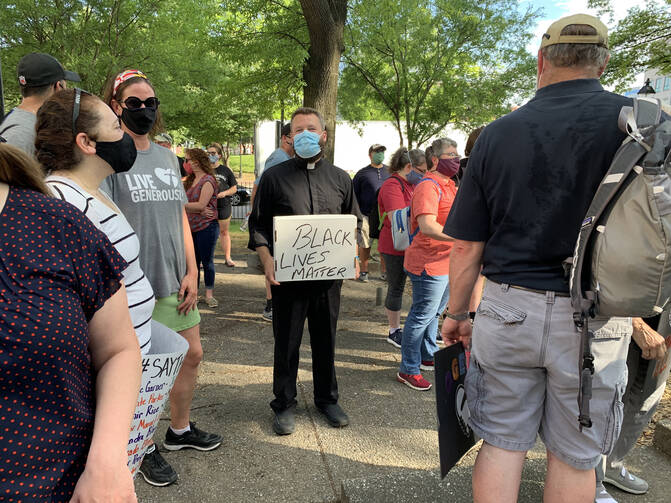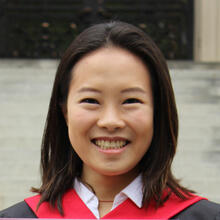“Today, we are here to affirm that all human lives are sacred,” announced the priest presiding at a vigil for George Floyd in Boston on a recent Saturday. The short homily made no mention of Mr. Floyd’s race, the cause of his death or police brutality in the United States. It was uncomfortably close to “all lives matter” platitudes.
The 30-minute vigil never included the words “black” or “African-American.” The word “racism” was only used once. I stood in the back of the almost-all-white crowd, watching one white person after another step up to read Scripture and offer prayer intentions to “end all violence.”
Standing before the Catholic church in a majority-black neighborhood, I couldn’t help but ask: Where are the black voices in this vigil? Where is the affirmation that black lives matter?
I couldn’t help but ask: Where are the black voices in this vigil?
As many Catholic parishes, schools and communities hold vigils and prayer services for the black lives lost due to racialized violence, vigils like these often miss the mark.
The vigils for George Floyd, Ahmaud Arbery, Breonna Taylor and countless other black Americans violently killed by white police officers and citizens ought not to be indifferent to the sin of racism. Mourning in a passive voice that “George Floyd has been tragically killed” is not enough. Instead, we can and should say, “A police officer killed George Floyd.”
Likewise, affirming the dignity of all human lives is not enough. In order for all lives to matter, we must focus on black lives today, which are among the most vulnerable in the United States. We must focus on black lives as part of Catholic social teaching’s preferential option for the poor and marginalized.
Catholic vigils must speak truth by naming the structures of racism and police brutality as the violence that disproportionately condemns our black siblings to death. Catholic vigils for black lives must speak truth with precision of language. Catholic leaders must place black experiences of life, death and injustice at the center of these vigils. As Olga Segura writes in America, Catholic leaders must affirm that black lives matter.
A week before the Boston vigil, my alma mater, the University of Notre Dame, hosted a vigil called A Prayer for Unity, Walk for Justice. The university’s president, John Jenkins, C.S.C., opened his remarks with a condemnation of the violence of the racism perpetuated against black Americans. But he soon transitioned to expressing gratitude for police officers: “Whatever our reaction to Mr. Floyd’s death, it must not be to smear the work and reputation of the thousands of good officers who serve us.”
I recalled the many times my black classmates have recounted to me their experiences of racial profiling by campus police. And I wondered: Where was the call for racial bias training and increased accountability for campus and municipal police officers?
Catholic vigils must speak truth by naming the structures of racism and police brutality as the violence that disproportionately condemns our black siblings to death.
Father Jenkins also said that protest should be peaceful: “The violence, the burning, the shooting will not serve the cause of justice. It will only perpetuate the violence.” He cited the nonviolent protests of the civil rights movement of the 1950s and ’60s to warn that “we should not allow violence and hatred into our hearts.” This is a good principle, but we should remember that the earlier civil rights movement was widely seen as uncivil, subversive and even violent at the time. We must be careful not to romanticize it in such a way that any mistakes by the protesters of today—or any instances of violence by opportunists who do not have social justice at heart—are used to condemn the act of public protest itself.
At funerals for people killed by drunk drivers, ministers do not remind attendees that most drivers are, in fact, capable of driving safely. When vigils jump from mourning George Floyd’s death to applauding good police officers, they can seem to delegitimize the grief and grievances of the black community. And downplaying these grievances in pursuit of an unearned message of reconciliation can actually reduce the pressure for policy change and action against police brutality and racial profiling.
Vigils can also inadvertently perpetuate myths about racism. I saw a rosary procession online in which a priest proclaimed, “We offer this time of prayer in reparation for all the sins of racism committed by all races in the United States of America.” Such a statement perpetuates the myth that people of color are responsible for reverse racism against white Americans.
Vigils are times of mourning, remembrance and listening. When vigil organizers focus on condemning violent protestors and praising police officers, they become complicit in society’s dismissal of black Americans who voice their grievances. They fail to truly listen to the black community, to its grief and to its demands for structural change. And when white Catholic leaders cling to microphones during vigils for black lives, black Catholic voices go unheard.
Not all vigils miss the mark. On June 1 in El Paso, Tex., Bishop Mark Seitz and 12 other priests knelt in silence for 8 minutes and 46 seconds—the same amount of time the Minneapolis police officer Derek Chauvin had knelt on George Floyd’s neck—while holding signs that read “Black Lives Matter.” Bishop Seitz called upon Catholic leaders to listen to the grievances voiced by centuries of black Americans. Rather than focusing on any perceived excesses by protesters, Catholic leaders ought to focus on their own responses to systemic racism, Bishop Seitz exhorted, quoting Cardinal Blase J. Cupich of Chicago.
Conclude the vigil with a concrete call to action.
And in Boston on May 31, an ecumenical coalition of Protestant and Catholic clergy organized a prayer march for racial justice. Black clergy members led and preached at the march, while white clergy members assisted. The prayer march concluded with calls for justice, such as the prosecution of those involved in recent killings and a more equitable distribution of resources that prioritize historically marginalized communities.
These examples illustrate specific ways to ensure that vigils do justice to those whom they commemorate.
First, amplify black voices in the community. Invite black members of your community to lead the vigil and offer their own reflections. If your community does not have black members, read an excerpt of writing from a contemporary black writer on racial justice instead of writing your own reflection. Alternatively, spread the news about black clergy-led vigils in the area, rather than organizing a separate event.
Second, use specific language that centers the black experience. Vigils for black lives must name the reality of racism and anti-black violence. Vague calls for the protection of all lives further conceal the reality of racism that white and non-black Catholics must confront.
Third, conclude the vigil with a concrete call to action. This includes action for racial justice that could be done at an individual level, parish level and nationwide. At the vigil, commit to some of these actions on the parish or community-level, such as a racial justice-related movie screening or a letter-writing campaign to local representatives.
Standing among the majority-white crowd in Boston, I lamented how a vigil intended to mourn deceased black lives had inadvertently silenced living black voices—their voices of grief and holy anger, their calls for justice and social change. During the brief moment of silence for George Floyd, I prayed for a day when vigils of remembrance become calls to repentance. Only when vigils compel white and non-black Catholics to repent their sins of racism and their participation in structures of privilege, can we begin to pray for and imagine a church in which black lives truly matter.











